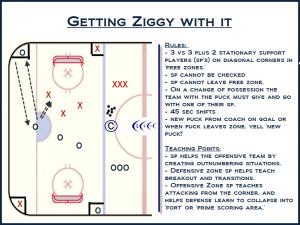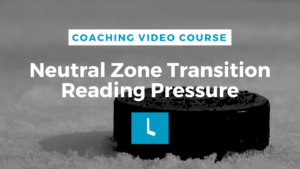How to Lead a Great Hockey Skill Practice:
The following template works extremely well because it makes the best use of assistant and junior coaches. The goal of these skill development sessions is to develop an association wide interest in fun, motivating, and engaging practices for both coaches and players. As 70% of every session will be run using small area stations, the program cannot succeed without the participation of the coaches.
It’s our philosophy that by coordinating and overseeing these sessions, with heavy active participation from the coaches, we can:
- Better teach and interact with the players.
- Have a greater impact on the association as a whole.
- Share knowledge and empower coaches.
- Get players the personal attention and repetitions they deserve.
- Increase passion for skill development.
- Use small area hockey games as a teaching methodology
- Facilitate a ‘Trojan Horse’ approach to skill development whereby coaches and kids are competing, having fun, working closely together, having fun, and improving as a group as well as individuals.
Flow of practice:
99% of the time we’ll start with a warm up game, then design and oversee the skill stations for the middle portion of the practice. We’ll then finish with another game in the final ten minutes. By warming up and finishing with small area games that have many teachable moments, we feel the energy of the kids stay sky high through the entire session. We want kids to love hockey. Starting and ending with great energy (while teaching) makes kids want to come back to the rink every day. That is the most important part of our job.
Curriculum:
As each team will be with us approximately 10 times in a season (every second week), we often use our Hockey Drills curriculum. Session 1 will build into session 2, and so on. Each day we learn a new small area game, then play it the following session at a greater level of success. For many reasons we will have to flex on the fly and accommodate the group based on a number of fluid factors, but for the most part we will do our best to stick with the curriculum.
Specific coach requirements and benefits:
There needs to be at least one coach at each station, managing the players, and keying on a few specific teaching points that the lead coach needs to point out ahead of time. At least 6 coaches are very much needed and actively engaged every session (we generally divide the ice into 6 zones). By you, the coach, running the station, you actively analyse and critique the level of success the players are having. You will very quickly begin to see common successes, as well as common areas of weakness among the group. It’s at this moment that the art of coaching arises: finding ways to connect with each individual player to celebrate their success, and give constructive criticism in their areas of weakness. It also gives you a chance to bring your own coaching skill, passion, and teaching style to the sessions.
Hockey Skill Practice: Lead Coach Responsibilities:
- Organize and delegate roles and responsibilities
- Design the practice plan
- Oversee and implement small changes to drills based on the ability of a specific group to handle the drill.
- Add layers for stronger groups, and simplify the drill for more novice players.
- Keep the energy and enthusiasm high
- Communicate with players and coaches
- Ensure that we are maximizing our time together.
Hockey Skill Practice: Assistant Coach Responsibilities:
When the assistant coaches hit the ice the lead coach should have a set of stations drawn on the white board. In a perfect world this can all happen ahead of time, but in many situations coaches are arriving at varying times, for a variety or reasons right?! You can come by the board, get your first assignment, check how to set up the drill, hear the key points on which to focus, and ask any questions that you have. While the lead coach brings in the players to explain the round of drills the coaches can begin setting up their drill. Coaches with a strong hockey background and coaching skill set should be assigned to more complexed drills. Those coaches with lower skill sets or lack of leadership development can take on smaller roles in which they are comfortable.
Be engaged, stay in the moment, and find the great pleasure in giving personal feedback to every player that participates in your drill. Each drill lasts 5-6 minutes, so please get it started quickly, help players get the repetitions they need, and then give personal feedback to players as the drill flows.Regardless of the drills chosen, having a general template helps keep coaches on task and efficient. Players love to know what is expected of them and a consistent practice template with moving parts and new drills will help them stay energized yet focused. Good luck!







